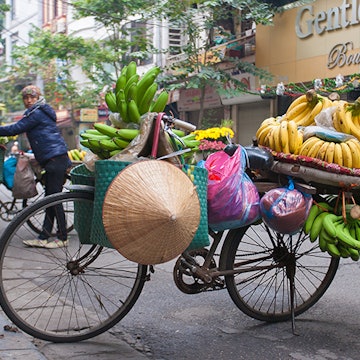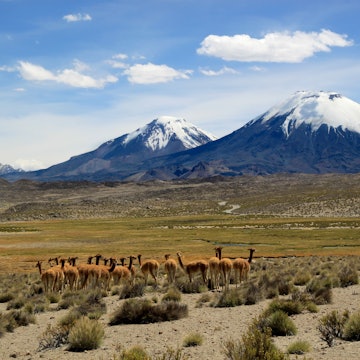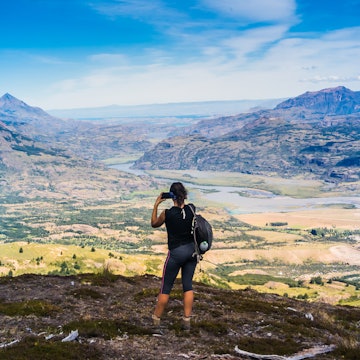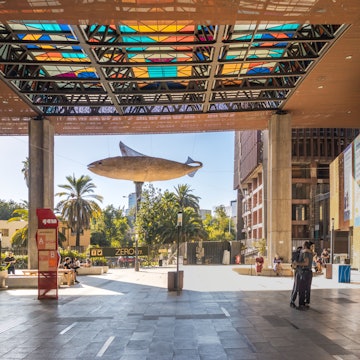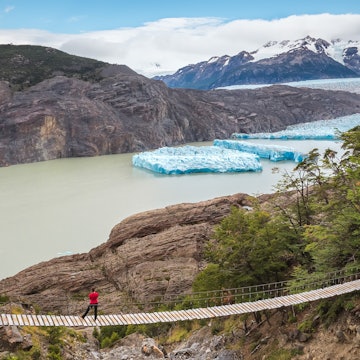

A hiker stands in awe of the huge granite peaks of the three Torres del Paine, part of the larger range of the Cordillera Paine.
Stretching from the belly of South America to its foot, Chile is nature on a colossal scale. Travel here is surprisingly easy if you don’t rush it. Start amidst the granite spires of Torres del Paine National Park in Patagonia, and then travel north to Valparaíso, a poetic and boisterous seaside town. Succumb to the spiritual magnetism of the Elqui Valley before striking out for the arid canyons and volcanoes of the Atacama Desert.
This article appeared in the Winter 2017 issue of Lonely Planet magazine's U.S. edition.
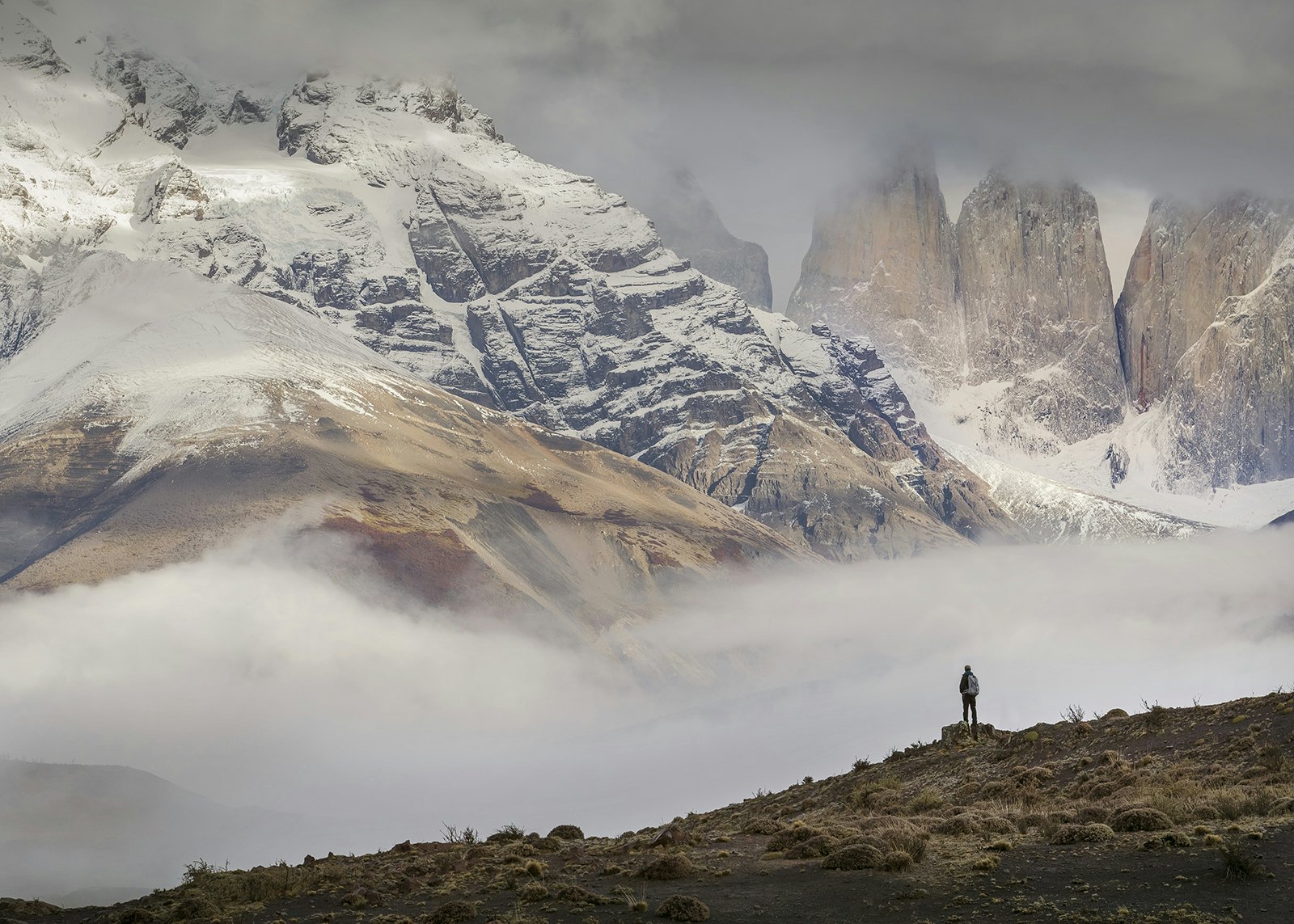
Torres del Paine National Park
Head to the Patagonian wilderness to paddle among icebergs in the shadow of mighty granite peaks.
The Andes pass many spectacular landscapes on their 4000-mile journey along South America’s spine. There are the terraces of Machu Picchu in Peru, the green hills that rise from the Caribbean in Colombia, and the first tributaries of the Amazon basin. But it is at the southernmost point of the continent where the mountains reach their grand finale – and save the best for last.
Torres del Paine National Park is the geological masterpiece of the Andes; it is a place where the weather patterns of the Pacific and Atlantic converge, destroying hikers’ tents and sculpting granite mountains into crooked, forbidding forms.
Once a backwater of remote cattle herders, guanaco herds and the odd puma, the park now brings in adventurers for trekking, mountaineering and horseback riding in this little Mordor at the end of the world. Among them is Cristian Oyarzo, a local with an infectious grin and a salt-and-pepper beard, who has pioneered a different way of exploring the park.
'With a kayak you can get to places no one else can,' he says, casting off from a pebbly beach on the shores of Lake Grey. 'You get a different perspective when you are down on the water.'

We glide out onto the lake, passing forests of Antarctic beech that reach down to the shore. Snowy summits appear between gaps in the storm clouds; among them are the vertical spires of rock – towers, or 'torres' – that lend the park its name. Ahead are more icy pinnacles: icebergs afloat on the lake, sailing southward, carried by the wind.
'Every time you paddle among icebergs it is different,' Oyarzo says. 'They are always changing forms and color. Once you paddle among them, you never want to return to land.'
The icebergs are vessels made of millennia-old ice: broken fragments of the massive Grey Glacier, which begins in the Patagonian Andes to the west and terminates at the lake’s northern reaches. The glacier – one of the park’s most spectacular – is a branch of the Southern Patagonian Ice Field, one of the world’s largest expanses of ice.
At 6500 square miles, it is a frozen wilderness so vast and uncharted that neither Chile nor neighboring Argentina can decide precisely where their territory ends and begins. It is, however, under threat: the Grey Glacier is rapidly shrinking, decreasing in width and thickness as a result of climate change.

Closer to the icebergs, the creaking of ice is audible above the splash of kayak paddles. The icebergs’ warped shapes bring to mind a Salvador Dali sketch or a Pink Floyd album cover. Some are pristine white; others have strata of deep blue. Some are the size of a double-decker bus, though few survive longer than a few days before they are small enough to fit in a beer glass.
Frequently, they can be seen calving, or breaking apart. On more than one occasion, Oyarzo heard a sinister rumbling up above and had to frantically paddle out of the way of a collapsing tower of ice.
'This is the way to see the ice in Patagonia,' he says. 'When you come so close you can touch it.'
The icebergs sparkle in the afternoon sunlight, as little waves lap against their base. Oyarzo puts down his paddle, and for a few moments joins them in their slow, silent drift along the cold waters of the lake.
From Torres del Paine, it’s a 90-minute drive to Puerto Natales airport, a three-hour flight to Santiago and another 90-minute drive to Valparaíso. Alternatively, pack some snacks for the nonstop 40-hour road trip northward through Chilean and Argentine Patagonia.
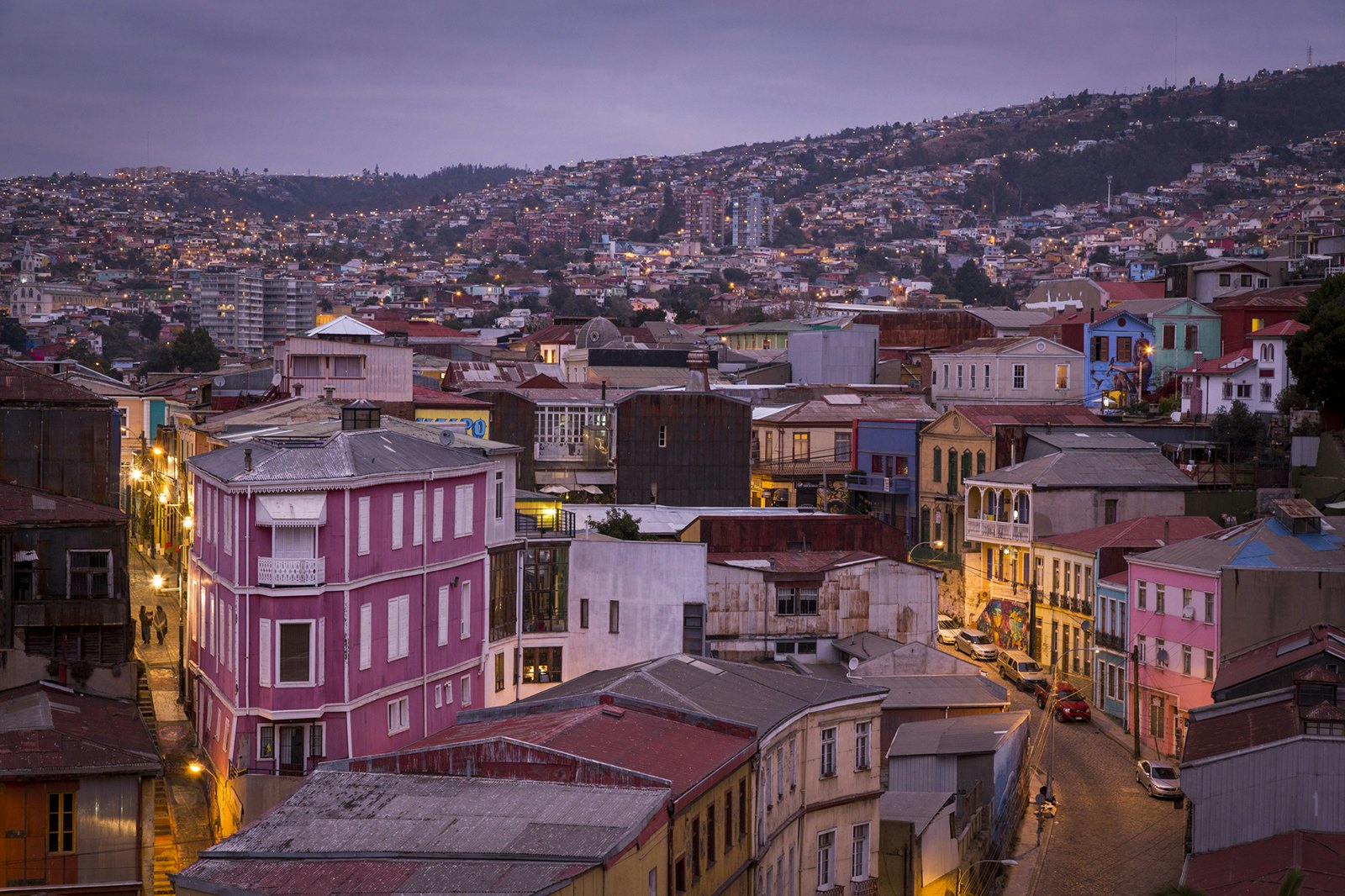
Valparaíso
Scale the hills and wander the waterfront of Valparaíso, Chile’s poetically disheveled port town.
Luis Segovia yanks a lever, and a commotion begins beneath his feet. It starts with a gentle shuttering, before growing to a symphony of rattling cogs, creaking wheels and spluttering engines – the soundtrack to Valparaíso life, in one form or another, since the mid-19th century.
'It is a joy doing my job,' says Segovia as he watches a car full of beaming passengers inch down the hillside before him. 'My life belongs to these funiculars; they are the spirit of our city.'
For four decades, Segovia has been a funicular operator in Valparaíso, a city that claims the peculiar distinction of having the highest concentration of these contraptions anywhere in the world. Their existence is partly owing to the city’s location – straddling a range of steep hills in central Chile’s Pacific coast. But in many ways they mirror the character of the city they serve: unorthodox, scruffy, full of legends.
The port of Valparaíso was once known as the Jewel of the Pacific. Families from across Europe emigrated to make their fortune here in the 19th century, growing rich on shipments of California gold and building mansions from whose verandas they could watch cargo ships bobbing out at sea. The opening of the Panama Canal in 1914 suddenly rendered Valparaíso useless as a port, and ever since then the city has been in a state of graceful decay.
Today, weeds and stray cats occupy grand townhouses where prosperous merchants once lived, and glassless windows look out over empty wharves. The town’s aura of melancholy has inspired painters, musicians and poets. No resident was more famous than Chile’s greatest writer, Pablo Neruda, who called Valparaíso 'a wonderful mess,' adding, 'How absurd you are... You haven’t combed your hair, you’ve never had time to get dressed, life has always surprised you.'
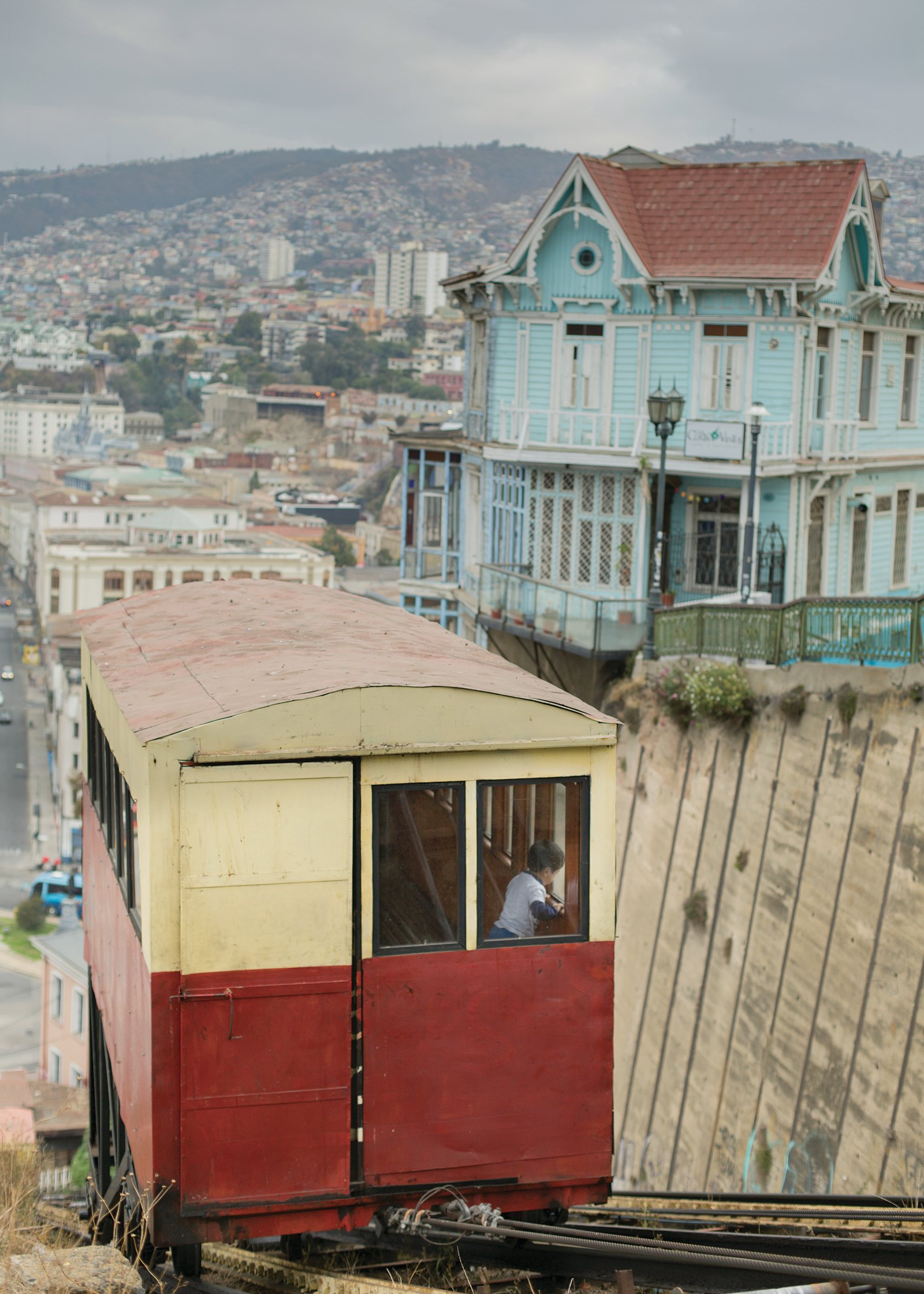
Once a symbol of modernity and progress, Valparaíso’s funiculars also fell on hard times. Of around 40 that were built (no one seems to know exactly how many), only nine are operational today. Fortunately, a slow process of restoration is underway. The funicular that Segovia is operating, the Ascensor Barón, underwent a full refurbishment five years ago that restored its century-old German machinery back to full working order.
'Every neighborhood identifies with its own funicular,' Segovia explains as another car hauls into view. 'Funicular operators know all their customers too. Many romantic encounters have taken place here. Couples sometimes rendezvous in a funicular car and go their separate ways. I even met my wife on a funicular.'
During a ride on the Ascensor Barón, the view quickly expands from chaotic city streets to serene heights where the sea breeze wafts through open windows. The frigates of the Chilean Navy appear in the distance; closer, the view encompasses hilltop palaces with turrets, church spires and thousands of pastel-colored houses cascading down the hillsides.
Other funiculars offer a more intimate view of the city: you can rattle in among laundry lines and chimney tops, sneaking a glimpse into living rooms where families watch TV. There is nowhere better than a funicular to ponder the fortunes of Valparaíso, a city capable of giddy heights, but also prone to sudden rises and falls.
From Valparaíso, take a six-hour drive north on Highway 5, before bearing east on Highway 41 for 90 minutes among the scrubby hills of the Elqui Valley.
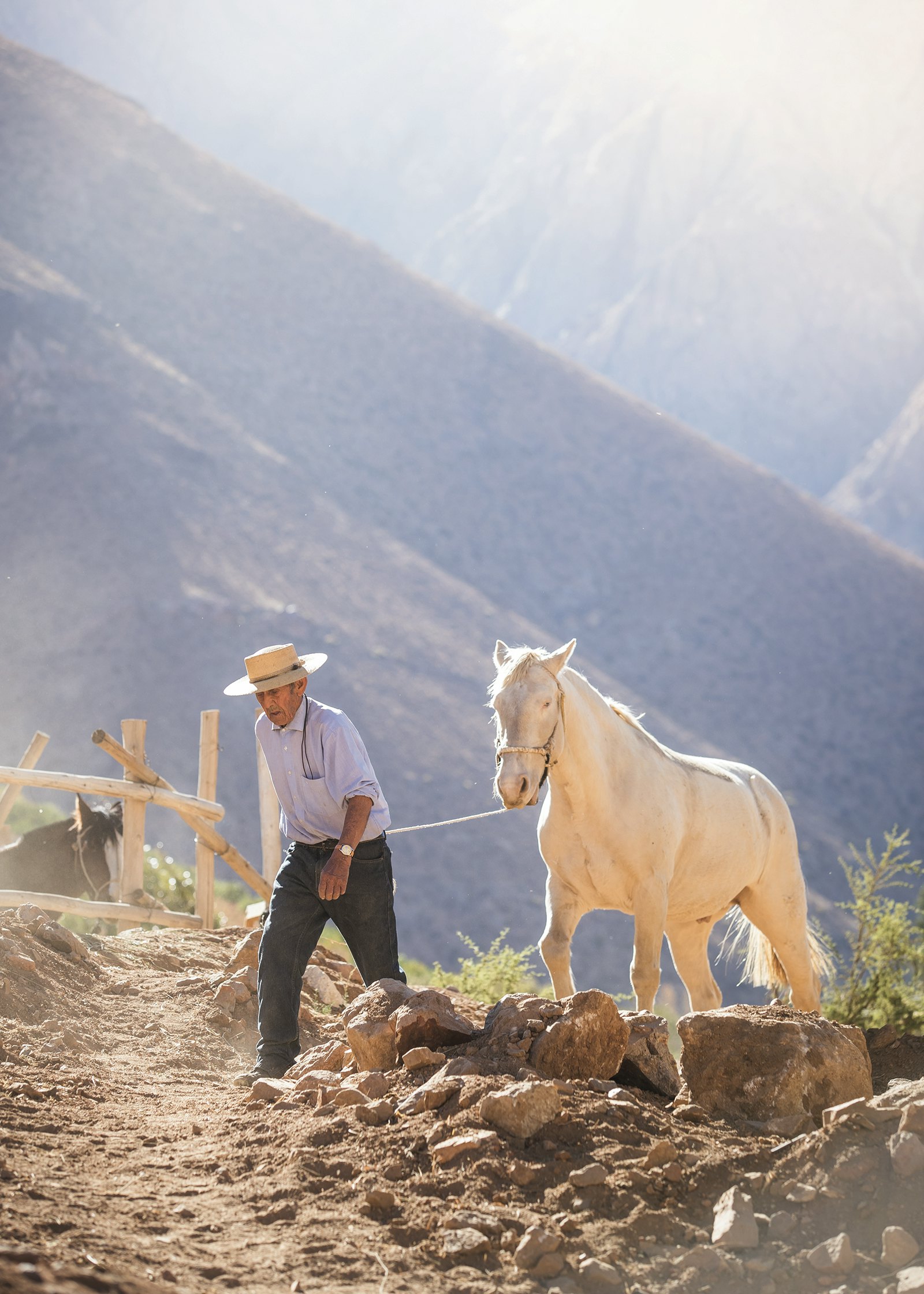
Elqui
Explore the dusty trails of the Elqui Valley, a home to quiet vineyards, sleepy market towns and a force field of cosmic energy.
Winemaker Marcelo Remetal stands beneath a pyramid made of tree trunks, his eyes closed and the palms of his hands upturned in silent meditation. The first rays of morning sunshine clear the barren mountains above, illuminating rows of vines that cascade down the slopes around him.
'There is an energy that you feel in your hands when you stand here,' he says, breaking from meditation to pick a few grapes. 'I feel a strong spiritual force. It is in my fingertips. I think you can find it in the wine that we make too.'
In the five centuries since Spanish conquistadors first imported vines from Iberia, Chile has enjoyed a distinguished winemaking tradition. The fertile hills around Santiago have produced award-winning vintages to make Old World winemakers choke on their Bordeaux.
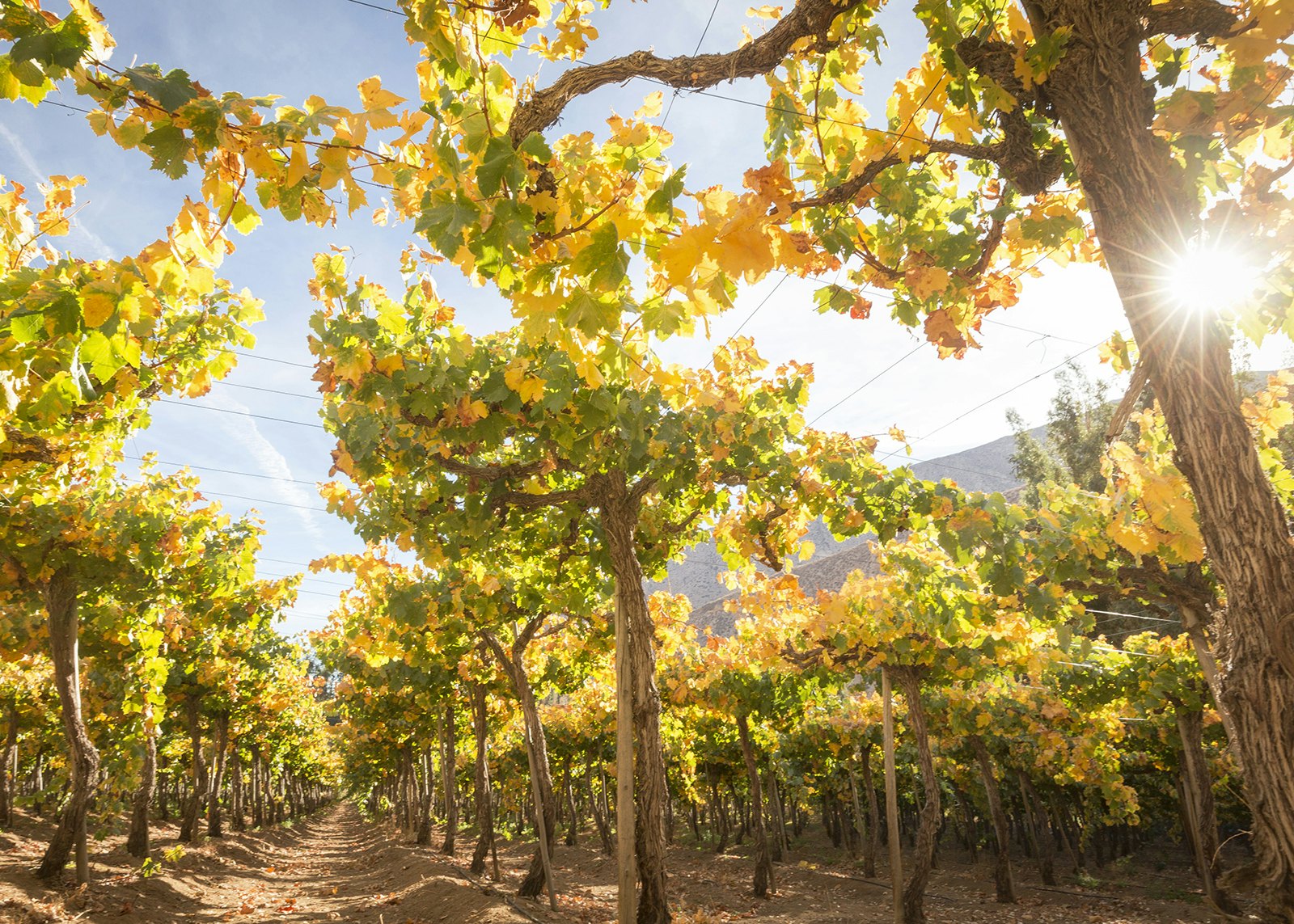
The Elqui Valley, however, represents the new frontier for Chilean wine pioneers: an area that almost qualifies as a desert, with loose soil, steep slopes and a near-total lack of rainfall. Yet miraculously, bursts of greenery appear among this dry expanse. There are groves of slender cypress trees, shady fruit plantations and rushing streams that mysteriously emerge from the mountainside.
'This valley lives because of snow,' says Remetal, gesturing toward the eastern mountains. 'The meltwater from the High Andes filters through the rock and irrigates our vines. I think the best wine is in extreme places like this.'
Remetal’s winery, Vinedos de Alcohuaz, has become one of Chile’s most respected since first producing bottles five years ago. It occupies a plot of land that once belonged to a shamanic healer (hence the wooden pyramid) and is run with an explicit reverence for Pachamama, the goddess of the Earth in Andean cosmology. This is not an unusual business model in the Elqui Valley, South America’s New Age heartland.

Along winding country roads are thatched-roof farmhouses where Tibetan prayer flags hang in the gardens, and sleepy market towns where the scent of exotic herbs wafts about, The Dark Side of the Moon plays in the cafes, and VW camper vans are parked in the streets.
Some say Elqui’s spiritual aura stems from a magnetic property in the soil, or that its power flows from the Himalayas on the exact opposite side of the earth. Cynics might ascribe it to the potency of pisco, the powerful brandy that has been distilled in Elqui for centuries and liberally consumed in pisco sours and other cocktails across Chile. Others say it is down to Elqui’s altitude and proximity to the stars – sure enough, telescopes and astronomical observatories dot the hilltops, taking advantage of some of the clearest skies on earth.
Whatever the cause, cosmic vibes are unquestionably in evidence at the Artisan Village of Horcon, set by a rushing river close to the highest point of the valley. Here, hammocks and wind chimes sway in the warm breeze while artisans paint mandalas and fashion dream catchers in tribute to the landscapes around them.
'Everything here has its own individual energy,' says Andrea Riviera Stefanini, a designer who works at an artisan cooperative at the top of the Elqui Valley. She makes jewelry from local quartz, and shawls and dresses inspired by the landscape’s color palates. 'It is all magic: the silence, the blue of the sky, the white of the moon, the sound of the water in the river. It makes it a paradise.'
From La Serena, catch a flight north to Calama. From here it’s a 90-minute drive along Highway 23 to the town of San Pedro de Atacama.

Atacama Desert
Experience the surreal landscapes of the Atacama, the driest place on the planet.
Stretching 2653 miles from north to south and averaging 110 miles in width, Chile seen on a map can appear less like a country and more like a cross section of South American climates. Its territory spans subpolar steppe, dense rainforests, snowy mountains and hills that bask in Mediterranean temperatures. At its lower latitudes are fishing villages lashed by hail, sleet and snow. And at the top is the vast expanse of the Atacama, a place where some weather stations have never known a single drop of rain.
'In a place like this, you must sit down and listen to the silence,' says park ranger Manuel Eric Silvestre Gómez, looking out over Laguna Chaxa, a salt lake in Los Flamencos National Reserve. 'You must contemplate the mountain range, hills and volcanoes, observe the skies and the moon. You’ll realize how small we are in this world.'
There are many forbidding deserts in the world, though the one around us manages to look forbidding in a great many ways. To the east, sullen-gray volcanoes rise along the Bolivian border, periodically raining lava on the surrounding landscape. To the north and west are burnt-red cliffs and canyons, beyond which geysers send plumes of steam into a cloudless sky. And here, at the center of it all, is an expanse of emptiness, a swathe of landscape where the creation gods seem to have taken a break. Featureless salt flats the color of freshly fallen snow stretch as far as the eye can see.

Featureless, that is, except for the addition of flamingos, creatures whose presence here seems strangely incongruous. Silvestre, a soft-spoken ranger with a mane of jet black hair, is charged with protecting the three flamingo species that inhabit the Atacama Desert: the Andean flamingo, the Chilean flamingo and James’s flamingo, all of which spend their days stalking through saline pools and gobbling tiny crustaceans. In Laguna Chaxa, the flamingos appear as bursts of pink in the midst of the whiteness.
'Flamingos are sacred to the indigenous Andean peoples,' Silvestre says, squinting through binoculars. 'They carry a special symbolism: their feathers are used to perform certain rituals and tributes to Pachamama, the Earth Mother. We must protect them, because they are our siblings.'
Flamingos are among the few species to have adapted to life in this desert, a habitat unique on the planet; Andean foxes and Darwin’s rheas also roam here, while condors wheel high above.

The Atacama is part of a highland plateau, sandwiched between the Andes and the Chilean Coast Range. These two ranges act as a barrier to weather systems, helping make the Atacama the driest place on earth outside the polar regions. It is also the highest hot desert on earth, all the while managing to look like a place that doesn’t belong on the planet at all. It is no coincidence that Mars rovers are tested here before being blasted into outer space.
Indigenous Atacameño people tell many legends explaining the formation of these varied landscapes: jealous kings whose rage caused volcanoes to explode, and the 40 days of torrential rain that washed away all life in the desert (ending only when there was no rain left in the sky). And yet somehow, gazing out at the salt flats, this feels like a planet in the very first moments of creation.
Oliver Smith traveled to Chile with support from Journey Latin America. Lonely Planet contributors do not accept freebies in exchange for positive coverage.
http://shop.lonelyplanet.com/world/lonely-planets-best-in-travel-2018/









